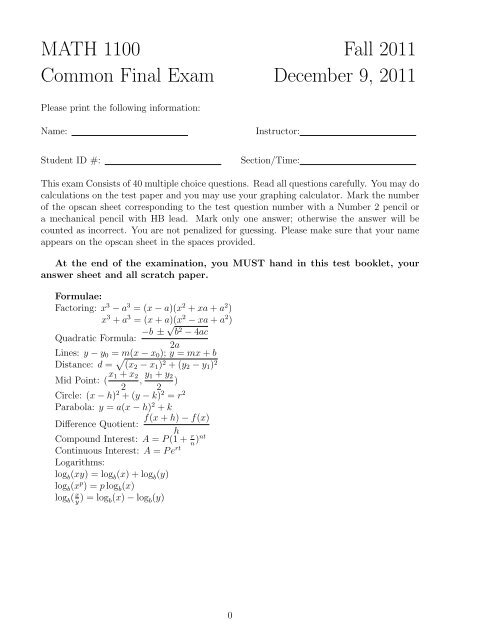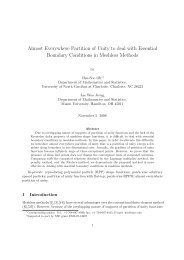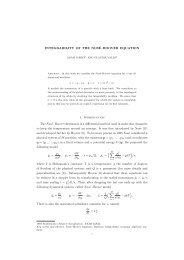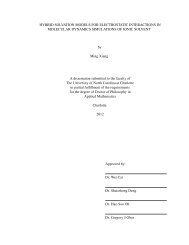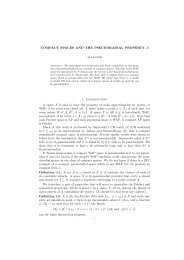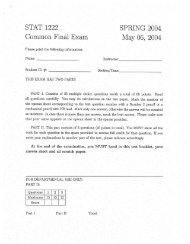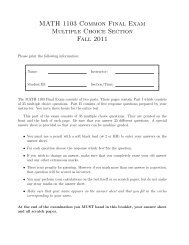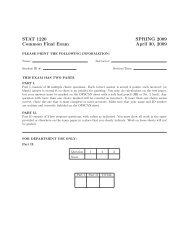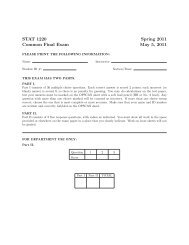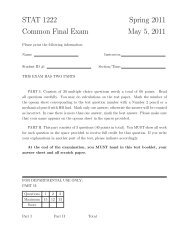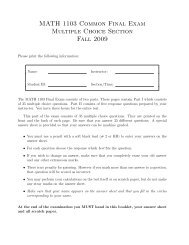MATH 1100 Fall 2011 Common Final Exam December 9, 2011
MATH 1100 Fall 2011 Common Final Exam December 9, 2011
MATH 1100 Fall 2011 Common Final Exam December 9, 2011
Create successful ePaper yourself
Turn your PDF publications into a flip-book with our unique Google optimized e-Paper software.
<strong>MATH</strong> <strong>1100</strong> <strong>Fall</strong> <strong>2011</strong><br />
<strong>Common</strong> <strong>Final</strong> <strong>Exam</strong> <strong>December</strong> 9, <strong>2011</strong><br />
Please print the following information:<br />
Name: Instructor:<br />
Student ID #: Section/Time:<br />
This exam Consists of 40 multiple choice questions. Read all questions carefully. You may do<br />
calculations on the test paper and you may use your graphing calculator. Mark the number<br />
of the opscan sheet corresponding to the test question number with a Number 2 pencil or<br />
a mechanical pencil with HB lead. Mark only one answer; otherwise the answer will be<br />
counted as incorrect. You are not penalized for guessing. Please make sure that your name<br />
appears on the opscan sheet in the spaces provided.<br />
At the end of the examination, you MUST hand in this test booklet, your<br />
answer sheet and all scratch paper.<br />
Formulae:<br />
Factoring: x 3 − a 3 = (x − a)(x 2 + xa + a 2 )<br />
x 3 + a 3 = (x + a)(x 2 − xa + a 2 )<br />
Quadratic Formula: −b ± √ b 2 − 4ac<br />
2a<br />
Lines: y − y0 = m(x − x0); y = mx + b<br />
Distance: d = (x2 − x1) 2 + (y2 − y1) 2<br />
Mid Point: ( x1 + x2<br />
,<br />
2<br />
y1 + y2<br />
)<br />
2<br />
Circle: (x − h) 2 + (y − k) 2 = r2 Parabola: y = a(x − h) 2 + k<br />
f(x + h) − f(x)<br />
Difference Quotient:<br />
h<br />
Compound Interest: A = P (1 + r<br />
n )nt<br />
Continuous Interest: A = P ert Logarithms:<br />
logb(xy) = logb(x) + logb(y) logb(xp ) = p logb(x) logb( x<br />
y ) = logb(x) − logb(y) 0
<strong>MATH</strong> <strong>1100</strong> FINAL EXAM <strong>Fall</strong> <strong>2011</strong><br />
1. Simplify the expression 3x + 2 − 4(2x − 1).<br />
(a) −5x + 6<br />
(b) −5x − 2<br />
(c) −5x + 1<br />
(d) 5x − 3<br />
(e) none of these<br />
2. Simplify √ x · 5√ x 2 and express your answer in radical form.<br />
(a) x 3<br />
(b) 5 √ x<br />
(c)<br />
(d)<br />
10 √ x 9<br />
5√ x 4<br />
(e) none of these<br />
3. The equation of a circle is x 2 − 6x + y 2 + 4y = 23, find its radius.<br />
(a) 2<br />
(b) 4<br />
(c) √ 23<br />
(d) 6<br />
(e) 8<br />
4. Determine whether the function f(x) = 2x 2 − 16x + 25 has a maximum value or a<br />
minimum value, and find it.<br />
(a) Minimum value, −7<br />
(b) Maximum value, −7<br />
(c) Minimum value, 4<br />
(d) Maximum value, 4<br />
(e) Minimum value, 25<br />
5. Determine which interval given below is the solution set of the inequality (2x−1) 2 ≤ 9.<br />
(a) [−1, 1]<br />
(b) (−1, 2]<br />
(c) (−∞, −1] ∪ [2, ∞)<br />
(d) (−∞, −1) ∪ (2, ∞)<br />
(e) [−1, 2]<br />
1
<strong>MATH</strong> <strong>1100</strong> FINAL EXAM <strong>Fall</strong> <strong>2011</strong><br />
6. Find the sum of the two solutions to the equation 6x 2 + 5x − 4 = 0. Your answer is<br />
(a) −5<br />
(b) 5<br />
(c) 0<br />
(d) −5/6<br />
(e) 5/6<br />
7. Solve the equation 2 log(x) − log 4 = log 2.<br />
(a) 4<br />
(b) log ± √ 8 <br />
(c) ± √ 8<br />
(d) 1<br />
log 8<br />
2<br />
(e) 2 √ 2<br />
8. Solve the equation 3x 2 − 7x + 3 = 0 using the quadratic formula:<br />
(a) { 10<br />
, −1}<br />
3<br />
(b) { 7 + √ 13<br />
6<br />
(c) { −7 + √ 13<br />
6<br />
, 7 − √ 13<br />
}<br />
6<br />
, −7 − √ 13<br />
}<br />
6<br />
(d) { 7 + √ 85<br />
,<br />
6<br />
7 − √ 85<br />
}<br />
6<br />
(e) no real solution<br />
9. A straight line goes through the points (−3, 5) and (0, 4). Find its slope.<br />
(a) 3<br />
(b) 1/3<br />
(c) 0<br />
(d) −3<br />
(e) −1/3<br />
2
<strong>MATH</strong> <strong>1100</strong> FINAL EXAM <strong>Fall</strong> <strong>2011</strong><br />
10. Simplify the expression<br />
(a)<br />
1<br />
xy 4<br />
(b) y4<br />
x<br />
(c) x<br />
y 4<br />
(d) x7<br />
y 3<br />
(e) x7<br />
y 4<br />
x 3 y −2<br />
(x −2 y 3 ) −2<br />
11. Find the domain of the function f(x) =<br />
(a) x > 4<br />
(b) x ≤ 4<br />
(c) x < 4<br />
(d) x ≥ 4<br />
(e) −4 < x < 4<br />
1<br />
√ 4 − x .<br />
12. Which of the following functions is neither an odd function nor an even function?<br />
(a) f(x) = x 2 + 1<br />
(b) f(x) = 3x 3 − 2x<br />
(c) f(x) = x(x 2 − 1)<br />
(d) f(x) = 4x 5 − 2x 3 + 3<br />
(e) f(x) = 5x 4 − 3x 2 + 1<br />
13. Perform the indicated operation and simplify:<br />
(a)<br />
1<br />
x2 − 1<br />
(b) −2<br />
x2 − 1<br />
(c)<br />
1<br />
x − 1<br />
(d)<br />
−2<br />
x2 − 2x + 1<br />
(e) −2x<br />
x2 − 1<br />
3<br />
1 1<br />
−<br />
x + 1 x − 1 .
<strong>MATH</strong> <strong>1100</strong> FINAL EXAM <strong>Fall</strong> <strong>2011</strong><br />
14. The graph of the function y = 4(x−2) 3 can be obtained from the graph of the function<br />
y = x 3 by which of the following transformations?<br />
(a) Shift to the right by 2 units, then shift up by 4 units;<br />
(b) Shift to the left by 2 units, then stretch vertically by a factor of 4;<br />
(c) Shift to the right by 2 units, then stretch vertically by a factor of 4;<br />
(d) Shift to the left by 2 units, then stretch vertically by a factor of 4;<br />
(e) None of the above.<br />
15. Use the Rational Zero Test to list all possible rational zeros of the polynomial 10x 4 −<br />
2x 3 + 4x 2 + ax − 6 (where a is just some integer). Which of the following numbers is<br />
not in your list?<br />
(a) −1<br />
(b) 1/2<br />
(c) −6/5<br />
(d) −3<br />
(e) 1/3<br />
16. Cathy bought her son a bicycle when it was on sale at 30% off its regular price. If<br />
Cathy paid $84 (before tax) for the bicycle, what was the original price of the bicycle?<br />
(a) $100<br />
(b) $110<br />
(c) $120<br />
(d) $140<br />
(e) $280<br />
17. Given that (1, −1) is the center of a circle and (−3, 2) is a point on the circle, find the<br />
radius of the circle:<br />
(a) 2 √ 5<br />
(b) √ 5<br />
(c) 5<br />
(d) √ 10<br />
(e) none of these<br />
4
<strong>MATH</strong> <strong>1100</strong> FINAL EXAM <strong>Fall</strong> <strong>2011</strong><br />
18. Solve the equation 2 − 3e 2x+b = −4 for x:<br />
(a) (ln(2) − b)/3<br />
(b) (log 2(e) − b)/2<br />
(c) (e 2 − b)/2<br />
(d) (ln(2) + b)/2<br />
(e) (ln(2) − b)/2<br />
19. Find the midpoint of the points (0, −5) and (4, 7).<br />
(a) (2, 1)<br />
(b) (2, 6)<br />
(c) (4, 12)<br />
(d) (−2, −6)<br />
(e) (−2, 1)<br />
20. Given f (x) = √ x 2 + x + 1 and g (x) = x 2 − 1, find (f ◦ g) (1) .<br />
(a) 4<br />
(b) 2<br />
(c) 1<br />
(d) √ 3<br />
(e) none of these<br />
<br />
2 −2x + 3x + 1 if x < 1<br />
21. Given f (x) = √ , find f (0) + f (1) + f (4).<br />
x + 5 if x ≥ 1<br />
(a) 9<br />
(b) 14<br />
(c) 17<br />
(d) 18<br />
(e) none of these<br />
22. A straight line has y-intercept 3 and is perpendicular to the line with equation 4x+5y =<br />
6. Its equation is:<br />
(a) y = 5<br />
x − 3<br />
4<br />
(b) y = − 5<br />
x + 6<br />
4<br />
(c) y = − 4<br />
x + 3<br />
5<br />
(d) y = 5<br />
x + 3<br />
4<br />
(e) none of these<br />
5
<strong>MATH</strong> <strong>1100</strong> FINAL EXAM <strong>Fall</strong> <strong>2011</strong><br />
23. Solve the inequality |x − 3| ≤ 2:<br />
(a) (1, 5)<br />
(b) [1, 5]<br />
(c) (−∞, 1] ∪ [5, ∞)<br />
(d) (1, ∞)<br />
(e) (−∞, 5]<br />
24. The price a painting company charges for a painting job (in dollars) varies directly<br />
with the area to be painted (in square feet). If your neighbor paid the company $1200<br />
to paint an area of 2500 square feet, how much would you have to pay if you hire the<br />
same company for a 3000 square feet painting job?<br />
(a) $1500<br />
(b) $1600<br />
(c) $1520<br />
(d) $1440<br />
(e) None of these<br />
25. If a − 2(a + 1) = 0 and b + 1<br />
(b − 1) = 1, find a + b:<br />
3<br />
(a) −1<br />
(b) 0<br />
(c) 1<br />
(d) 3<br />
(e) None of these<br />
26. Solve the inequality<br />
(a) (1, ∞)<br />
(b) (−∞, 4]<br />
(c) [1, 4)<br />
(d) (1, 4]<br />
(e) (−∞, 1) ∪ [4, ∞)<br />
3<br />
x − 1<br />
≥ 1 and express your answer in interval notation:<br />
27. Which of the following statements is NOT correct about the polynomial −3x 5 + 4x 3 −<br />
x 2 + ax + 3 (where a is some real number)?<br />
(a) It may have five local maximums and local minimums.<br />
(b) It may have up to five zeros.<br />
(c) Its graph has no asymptotes.<br />
(d) 3 is its y-intercept.<br />
(e) The right end of its graph goes down (to negative infinity).<br />
6
<strong>MATH</strong> <strong>1100</strong> FINAL EXAM <strong>Fall</strong> <strong>2011</strong><br />
28. Find the horizontal asymptote, if any, of the function f (x) = −x2 + x + 10<br />
2x3 .<br />
+ 1<br />
(a) y = 0<br />
(b) y = −1/2<br />
(c) y = 10<br />
(d) y = − 1<br />
2x<br />
(e) No horizontal asymptote<br />
29. The vertex of a quadratic function is (2, −1) and its graph goes through the point<br />
(1, −3). Find the function.<br />
(a) y = (x + 1) 2 − 2<br />
(b) y = 3<br />
2 (x − 2)2 + 1<br />
(c) y = 2(x − 2) 2 − 1<br />
(d) y = 3<br />
2 (x − 2)2 − 1<br />
(e) y = −2(x − 2) 2 − 1<br />
30. If (a, b) is the solution to the system of equations<br />
(a) 4<br />
(b) 3<br />
(c) 2<br />
(d) 1<br />
(e) 0<br />
x − 2y = 3<br />
2x + y = 1 , then a3 + b 3 equals<br />
31. James opened a CD (Certificate of Deposit) account with $3000 deposit. The interest<br />
is compounded continuously and the account balance doubled after 8 years. Find the<br />
APR (annual percentage rate).<br />
(a) .025<br />
(b) .05<br />
(c) (ln 8)/2<br />
(d) (ln 3000)/16<br />
(e) (ln 2)/8<br />
7
<strong>MATH</strong> <strong>1100</strong> FINAL EXAM <strong>Fall</strong> <strong>2011</strong><br />
32. The polynomial f(x) = −2x 40 + 5x 20 + 4x 2 − 7x + 1 is divided by x + 1. Use the<br />
remainder theorem to find the remainder.<br />
(a) 15<br />
(b) −17<br />
(c) 1<br />
(d) 5<br />
(e) −5<br />
33. If f(x) is an odd function and f(−1) = 4, then which of the following must be true?<br />
(a) f(−4) = 1<br />
(b) f(1) = −4<br />
(c) f(−1) = 4<br />
(d) f(1) = 4<br />
(e) f(−4) = −1<br />
34. Find the quotient when x 3 + 2x 2 − 3x + 4 is divided by x 2 + x − 2.<br />
(a) x + 1<br />
(b) −2x + 8<br />
(c) x − 1<br />
(d) −5x + 3<br />
(e) none of these<br />
35. Find the domain of the function f(x) = ln(3x − 6)<br />
(a) x = 2<br />
(b) (2, ∞)<br />
(c) (−6, 2)<br />
(d) (−∞, 6)<br />
(e) all real numbers<br />
36. log 5(13) is the solution to which of the following equations?<br />
(a) 5x = 13<br />
(b) 13 x = 5<br />
(c) x 5 = 13<br />
(d) 5 x = 13<br />
(e) 13 x = 5<br />
8
<strong>MATH</strong> <strong>1100</strong> FINAL EXAM <strong>Fall</strong> <strong>2011</strong><br />
37. Solve the equation log 5(2x + 1) = 2.<br />
(a) x = 4.5<br />
(b) x = 12<br />
(c) x = 14.5<br />
(d) x = 13<br />
(e) none of these<br />
38. Tom opened a savings account with an initial deposit of $5,000. The account has a<br />
fixed APR of 3.5% and the interest is compounded monthly. If Tom makes no further<br />
deposit, what will be the account’s accumulated value after 10 years (round off to the<br />
nearest cent)?<br />
(a) $157,490.87<br />
(b) $7095.34<br />
(c) $7,091.72<br />
(d) $7,052.99<br />
(e) $5,177.83<br />
39. Given that the range of the function y = f(x) is [0, ∞). Find the range of the function<br />
y = −f(x − 4) + 3.<br />
(a) (−∞, −3]<br />
(b) [−3, ∞)<br />
(c) [3, ∞)<br />
(d) (−∞, 3]<br />
(e) (−∞, 4]<br />
40. Given f(x) = 2x + 7, find f −1 (x).<br />
(a) 2x − 7<br />
x + 7<br />
(b) −<br />
2<br />
x − 7<br />
(c)<br />
2<br />
1<br />
(d)<br />
2x + 7<br />
(e) − x<br />
− 7<br />
2<br />
End of <strong>Exam</strong><br />
9


